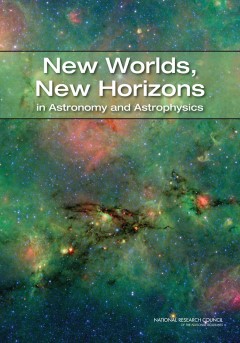New Worlds, New Horizons: Cover of New Worlds, New Horizons in Astronomy and Astrophysics. The Decadal Survey of Astronomy and Adtrophysics outlines a plan for ground- and space-based astronomy and astrophysics through 2019. Another Decadal Survey will be presented in 2020.
Credit: National Academy of Sciences
One of the first things astronomers do every decade is to get together and do a decadal survey. I was part of this last one that was released in 2010. When you're on the panel, you put on the big hat as we call it. We all try to take the attitude that all science is great, and we can't be chauvinists for our own wavelength fiefdom. When we're choosing the missions, and I mean missions in space as well as missions on the ground, we're choosing them based on the most important and interesting science problems. You don't get welfare for your wavelength band: the problem has got to be the most interesting scientifically.
The process is contentious in the sense that there are so many good ideas, so many well thought-out projects and telescopes and missions that they can't all be done. There's not enough money. Complicating that is the fact that in the previous decadal survey for astrophysics, the committee underestimated the total cost of the projects they recommended. Consequently, the selected projects haven't all been completed. They have overrun in cost, so there are going to be fewer things done, and what is done is going to take longer.
No one likes cost overruns. I'm remodelling a townhouse right now, and I don't want to hear any nasty surprises like it's going to cost double what they told me. So that's the problem. Not only that, cost overruns dry up the money for the projects we're waiting on. The next decade is then held hostage by the cost overruns of this one. So, you know, get in line.

